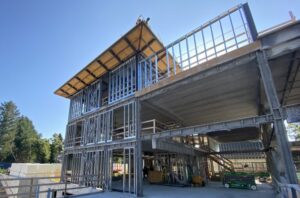According to National Association of Home Builders’s online newsletter Eye on Housing, the latest estimates show the rising softwood lumber prices over the last 12 months add $35,872 to the price of an average new single-family home, and $12,966 to the market value of an average new multifamily home.
Since the vast majority of new multifamily homes are built for rent, the $12,966 increase in value will boost annual rental receipts by $1,426. In other words, tenants are paying $119 more a month to rent the average new apartment due to the past year’s surge in lumber prices, says Eye on Housing.
Lumber Costs Catapult
On the single-family home, non-rental market front, Americans face sticker shock as they shop for new homes and budget for home improvement projects.
For example, at Vanguard Homes in Colorado Springs, single-family home prices spiked an average of $80,000 per house from July 2020 to February 2021. The lumber package alone added $26,000 — nearly one-third of the $80,000 increase, says The Colorado Springs Gazette in its April 25 article, “Soaring material costs create sticker shock for homeowners, builders and contractors.”
Colorado Springs general contractor Vince Colarelli, whose company, Colarelli Construction, builds medical offices, banks, restaurants, hotels and government buildings, says lumber prices normally increase in the 2% to 5% range each year. But this year, he expects lumber costs to catapult by 300% to 400%, according to Gazette.
“We typically see increases in costs every year, but the increase in costs this year is so extraordinary that it’s requiring us to rethink our approach to material selection and to building system design,” Colarelli says.
Instead of lumber, Colarelli says his firm is using cold-formed steel for framing on some projects. The switch to steel is providing his firm and his customers with savings.

The use of steel framing is becoming an attractive alternative to lumber due to its low cost and durability. The architect designed this home to have a life expectancy of more than 100 years.
‘About to Get Even Wilder’
The frenzy over lumber availability due to extraordinary high prices has not only taken over homebuilding, it’s taken over home repairs and remodeling as well.
A “pandemic-driven home renovation craze has contributed to making basic materials pricey and hard to come by,” says an article on Vox.
Demand for lumber has exploded in recent months, and prices have, in turn, skyrocketed.
“For years, the price of 1,000 board feet of lumber has generally traded in the $200 to $400 range. It’s now well above $1,000. (One board foot is 12x12x1 inches, and the average new single-family home takes about 16,000 board feet of lumber to construct.),” says Vox. “A new house that would have cost $10,000 in wood to get off the ground a couple of years ago now costs $40,000 worth of wood — assuming, that is, you can even get your hands on the lumber.”
Vox says the lumber frenzy is part of a string of unexpected and strange developments in the Covid-19 economy.
“Before there was the great run on wood of 2021, there was the great run on toilet paper of 2020,” says Vox. “The same lockdown boredom and extra cash that inspired some people to get into day trading animated people to decide it was time to fix up their homes.”
Vox adds, “The surge in demand and dearth of supply in lumber are causing all sorts of volatility and distortions in the market. The lumber futures market keeps hitting new highs, surpassing $1,400 per 1,000 board feet, and things might be about to get even wilder.”
‘We Need Alternatives to Wood’
According to the Traverse City Record-Eagle, experts predict high lumber prices to continue, “further hampering the start of new projects and escalating construction costs,” it says.
Because inflating lumber prices are making it difficult for some homebuyers to find affordable housing, “we need to consider alternatives to wood,” the Record-Eagle says, to offset the cost of lumber in the price of housing.
Framing lumber accounts for about one-fifth of the cost of building a home, the Record-Eagle says.
High-performance CFS metal framing, an alternative wall system to wood, is an ideal choice.
Article cited from BuildSteel.org
